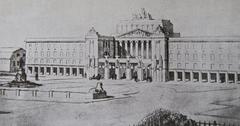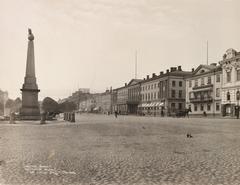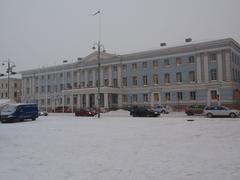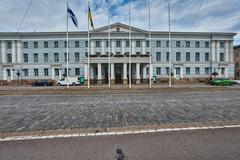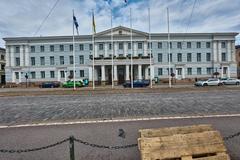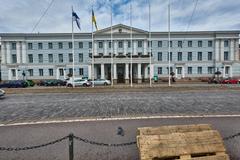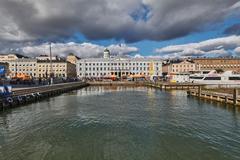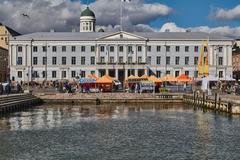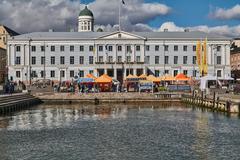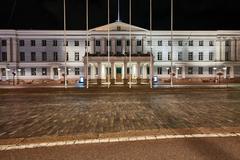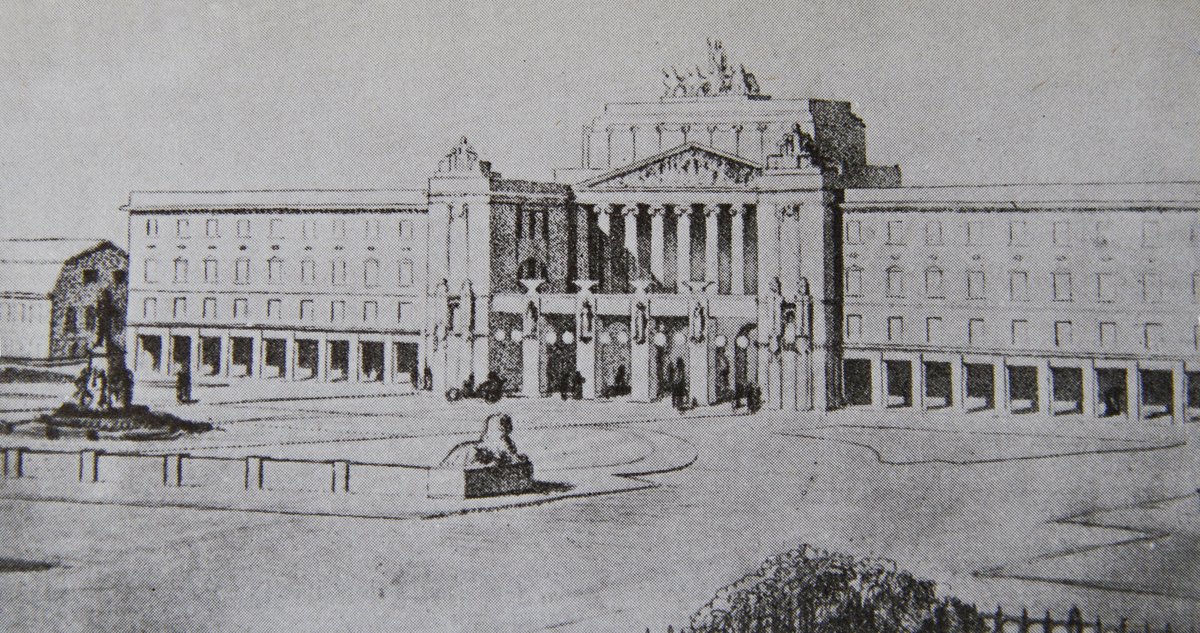
Helsinki City Hall Visitor Guide: Hours, Tickets, History, and Architectural Highlights
Date: 14/06/2025
Introduction
Helsinki City Hall is a landmark of both architectural and civic importance, located in Helsinki’s vibrant city center at Pohjoisesplanadi 11–13. Originally constructed as the Hotel Seurahuone in the 1830s by architect Carl Ludvig Engel, the building has evolved from a prestigious social venue into the administrative heart of the city. Today, Helsinki City Hall is renowned not only for its neoclassical architecture but also for its dynamic cultural programming, community events, and its role in local governance. Whether you are interested in history, architecture, or contemporary Finnish culture, this guide provides everything you need to know about visiting Helsinki City Hall.
For official visitor information, see the City of Helsinki’s official page and the MyHelsinki visitor portal.
Table of Contents
- Historical Overview
- Visiting Information
- Nearby Attractions
- Exhibitions, Events, and Amenities
- Architectural Highlights
- Frequently Asked Questions (FAQ)
- Visuals and Virtual Experience
- Summary and Recommendations
- Sources and Further Reading
Historical Overview
Early Foundations and the Lion Block
Helsinki City Hall stands within the historically significant Lion Block (Leijonakortteli), an area central to the city’s neoclassical Empire style. The block’s origins date to the late 18th century, with merchant houses established as early as 1763. Helsinki’s designation as Finland’s capital in 1812, under Russian rule, led to major developments based on J.A. Ehrenström’s city plan. Architect Carl Ludvig Engel played a pivotal role in shaping both the Lion Block and Helsinki’s broader cityscape (hel.fi static PDF).
The Hotel Seurahuone Era (1833–1913)
Constructed in 1833 as Hotel Seurahuone, the building was designed by Engel and immediately became Helsinki’s leading venue for social gatherings, concerts, and cultural events. Its neoclassical façade and grand banquet hall were emblematic of the city’s aspirations as a modern European capital (finnisharchitecture.fi; discoveringfinland.com; alluringworld.com).
Transition to City Hall (1913–1932)
In 1901, the City of Helsinki acquired the building. The hotel operated until 1913, after which it relocated, and the process of adapting the structure for municipal use began. Plans for a new city hall were delayed by World War I, but by 1932, the renovated building opened as Helsinki City Hall, with the City Council meeting in the grand Banquet Hall (finnisharchitecture.fi; hel.fi static PDF).
Modernization and Renovations (1960s–1990s)
A need for modernization led to a major architectural competition in 1960, won by Aarno Ruusuvuori. His design retained key historical elements—the façade, entrance colonnade, and banquet hall—while transforming interiors into a minimalist, modernist workspace. This approach, controversial at the time, fueled broader debates about heritage preservation in Finland (finnisharchitecture.fi; alluringworld.com). The building underwent further renovations in the 1980s and 1990s, including the restoration of the Bock House and the addition of a new Council Chamber (hel.fi static PDF).
Civic and Cultural Role
Today, Helsinki City Hall houses the Mayor’s office, hosts City Council meetings, and serves as a venue for exhibitions, concerts, and public events. It features contemporary Finnish art, such as Eino Ruutsalo’s “Valoseinä,” and continues to function as both an administrative hub and an accessible cultural space (discoveringfinland.com; myhelsinki.fi). The City Hall’s Event Square, redesigned in 2018, exemplifies its role as a welcoming “open living room” for residents and visitors alike (historia.hel.fi).
Visiting Information
Opening Hours
- Monday to Friday: 9:00 AM – 6:00 PM (Event Square and public spaces)
- Extended hours until 8:00 PM on Thursdays (by arrangement)
- Closed on weekends and public holidays
- Check the official Event Square page for current schedules, as hours may vary due to events.
Admission and Tickets
- Admission: Free to all public areas and exhibitions
- Tickets: Not required for general entry; special events may require advance booking or registration (historia.hel.fi)
Guided Tours
- Guided tours are available by advance arrangement and during special events such as Helsinki Day (June 12).
- Tours provide access to the Banquet Hall, Council Chamber, and select historic spaces.
- Contact the City Hall or visit MyHelsinki for details.
Accessibility
- Wheelchair-accessible entrances and elevators
- Accessible restrooms available
- Trained staff can assist visitors with disabilities
- All public areas, including the Event Square and restaurant, are designed for barrier-free access (audiala.com)
Visitor Tips
- Combine your visit with nearby sites: Helsinki Cathedral, Senate Square, Market Square, and Uspenski Cathedral are all within walking distance.
- Photography is permitted in public and exhibition spaces, but may be restricted during official meetings—always check for signs or ask staff.
- Dress for the weather: Helsinki’s climate is changeable, especially along the waterfront.
- Public transport: Tram lines 2 and 4, as well as numerous buses, serve the area. The Rautatientori metro station is a short walk away.
- Plan ahead: Check current events and exhibitions before visiting (Events.hel.fi).
Nearby Attractions
- Market Square (Kauppatori): Lively market with food stalls, crafts, and ferry connections.
- Senate Square: Home to Helsinki Cathedral and neoclassical government buildings.
- Uspenski Cathedral: The largest Orthodox church in Western Europe.
- Presidential Palace: Historic residence, visible from the City Hall area.
Exhibitions, Events, and Amenities
Cultural Programming
- The City Hall’s Event Square is the main venue for exhibitions, public discussions, concerts, and municipal events.
- The Virka Gallery and other spaces regularly present photographic and contemporary art exhibitions, highlighting both Finnish heritage and emerging artists (historia.hel.fi).
- City Hall participates in city-wide festivals such as Helsinki Design Week, Helsinki Day, and the Helsinki Biennial (PR Newswire).
Amenities
- Virka-info: Multilingual information desk in the lobby provides guidance, maps, and recommendations.
- City Hall Restaurant: Offers Finnish and international cuisine in a relaxed atmosphere.
- Restrooms: Modern and accessible facilities, sometimes featuring creative design.
- Wi-Fi: Free throughout public areas.
Architectural Highlights
- Neoclassical Façade: Designed by Engel, facing Market Square, with classical columns and restrained ornamentation.
- Banquet Hall: Historic venue for receptions and city events, retaining period details.
- City Council Chamber: Modernized yet open to the public during meetings.
- Event Square: Contemporary, open-plan lobby space for exhibitions and gatherings.
- Art Installations: Including “Valoseinä” by Eino Ruutsalo and other notable pieces.
The City Hall’s architecture exemplifies Helsinki’s approach to balancing preservation with innovation, maintaining the building’s historical character while meeting modern needs (finnisharchitecture.fi; historia.hel.fi).
Frequently Asked Questions (FAQ)
Q: What are the Helsinki City Hall opening hours?
A: Monday to Friday, 9:00 AM to 6:00 PM. Extended to 8:00 PM on Thursdays by arrangement. Closed on weekends and public holidays.
Q: Is there an entry fee?
A: No, entry to public areas and exhibitions is free.
Q: Are guided tours available?
A: Yes, guided tours can be arranged in advance or during special events.
Q: Is Helsinki City Hall accessible?
A: Yes, the building is fully accessible, with step-free entrances, elevators, and accessible restrooms.
Q: Can I take photographs inside?
A: Photography is permitted in public and exhibition areas unless otherwise indicated.
Q: Are there dining options inside City Hall?
A: Yes, the City Hall restaurant serves both Finnish and international cuisine.
Q: What public events are held at City Hall?
A: The Event Square hosts concerts, exhibitions, lectures, and is a focal point for city festivals.
Visuals and Virtual Experience
- High-quality images of the City Hall’s neoclassical façade, Banquet Hall, Council Chamber, and Event Square are available on the official City Hall website.
- Virtual tours and photo galleries provide insight into the building’s architecture and exhibitions.
Summary and Visitor Recommendations
Helsinki City Hall is a testament to the city’s rich history, architectural heritage, and commitment to civic life. Its central location, free admission, and barrier-free access make it an inviting destination for all. Visitors are encouraged to explore the City Hall alongside nearby landmarks, participate in cultural events, and experience the seamless blend of historical elegance and modern innovation that defines Helsinki.
To enhance your visit, download the Audiala app for guided tours, event updates, and insider tips. For the latest official information, consult the City of Helsinki’s official website and MyHelsinki.
Sources and Further Reading
- Helsinki City Hall and the Lion Block, 2008, City of Helsinki (hel.fi static PDF)
- Helsinki City Hall, Finnish Architecture, 2024 (finnisharchitecture.fi)
- Discovering Finland: Helsinki City Hall, 2024 (discoveringfinland.com)
- Alluring World: Helsinki City Hall, 2024 (alluringworld.com)
- MyHelsinki: Helsinki City Hall Events, 2024 (myhelsinki.fi)
- NotAboutTheMiles: Helsinki City Hall Art and Culture, 2024 (notaboutthemiles.com)
- VisitFinland: Finnish Architecture Icons of Helsinki, 2024 (visitfinland.com)
- Helsinki History: City Hall and Administration, 2024 (historia.hel.fi)
- PR Newswire: Helsinki’s Cultural Highlights 2025, 2025 (prnewswire.com)
- Audiala App: Helsinki City Museum and Tours, 2024 (audiala.com)
